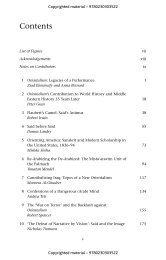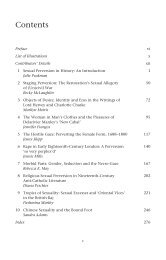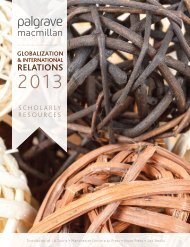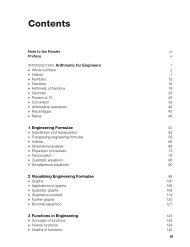Download sample chapter - Palgrave
Download sample chapter - Palgrave
Download sample chapter - Palgrave
Create successful ePaper yourself
Turn your PDF publications into a flip-book with our unique Google optimized e-Paper software.
Copyrighted material – 9781137343512<br />
10 / florence vatan and marc silberman<br />
assassination of Nazi leader Reinhard Heydrich in Prague in May 1942, the<br />
confrontation with the past becomes a source of inspiration for personal<br />
and collective action in the present. In the volume’s closing <strong>chapter</strong>, “Afterwords:<br />
Lessons in Memory and Politics,” Marc Silberman reflects on the<br />
ethical and pedagogical challenges raised by the transmission of the past. If<br />
the multiplication of memorial sites, historical museums, and public spaces<br />
of mourning demonstrate the growing awareness of the relevance of the past<br />
for our own present, the remembrance of a difficult past raises significant<br />
challenges when it comes to decide what and how it should be transmitted<br />
to younger generations. The <strong>chapter</strong> highlights some of the stumbling<br />
blocks one encounters when teaching about memory, for example, the distinction<br />
between historiography and memory studies, issues of truth, evidence,<br />
and authenticity, and the status of “invented memory” and media<br />
spectacle in representations of the past. The essay argues that for teachers<br />
of memory the specific object of attention should be a transformation of<br />
values, encouraging students to recognize competing views of the past that<br />
produce not the stories we want to hear but those we need to hear.<br />
The evocation of bones haunts this entire volume like a specter of the<br />
past: Russian children playing in the woods and discovering bones from<br />
human bodies, bones excavated as vestiges of the Spanish Civil War, bones<br />
on display in Rwandan, Cambodian, and European memorial sites, women<br />
searching for the remains of their “disappeared” loved ones in the Chilean<br />
Atacama desert. These bones are fragments, mutilated remains of violently<br />
decimated lives. They are also signs of recognition, symbols of connection<br />
and interconnectedness, and pieces of a puzzle which cannot be fully reconstructed.<br />
The search and excavation process reinserts them into the community<br />
of the living as a shared legacy through the intergenerational process of<br />
transmission. Walking through the ruins of Birkenau, Didi-Huberman was<br />
reminded of Walter Benjamin’s brief 1932 text “Excavation and Memory”:<br />
“He who seeks to approach his own buried past must conduct himself like<br />
a man digging. Above all, he must not be afraid to return again and again<br />
to the same matter; to scatter it as one scatters earth, to turn it over as one<br />
turns over soil.” 11 Benjamin’s remarks, Didi-Huberman goes on, reveal two<br />
things: First, the art of memory cannot be reduced to an inventory of excavated<br />
visible objects. Second, archeology is “not only a technique to explore<br />
the past; it is also, and above all, an anamnesis to understand the present”<br />
(64–65). In many respects the commemorative projects analyzed in this<br />
volume perform an archeology of violence. Individuals, groups, and institutions<br />
dig again and again into a collective past in order to retrieve silenced<br />
truths and forgotten glimmers of hope. Their projects make visible what<br />
has been erased, buried, or left unnoticed. Some expose divisions and contradictions.<br />
Others generate new forms of solidarity. Terrorscapes—many<br />
Copyrighted material – 9781137343512
















